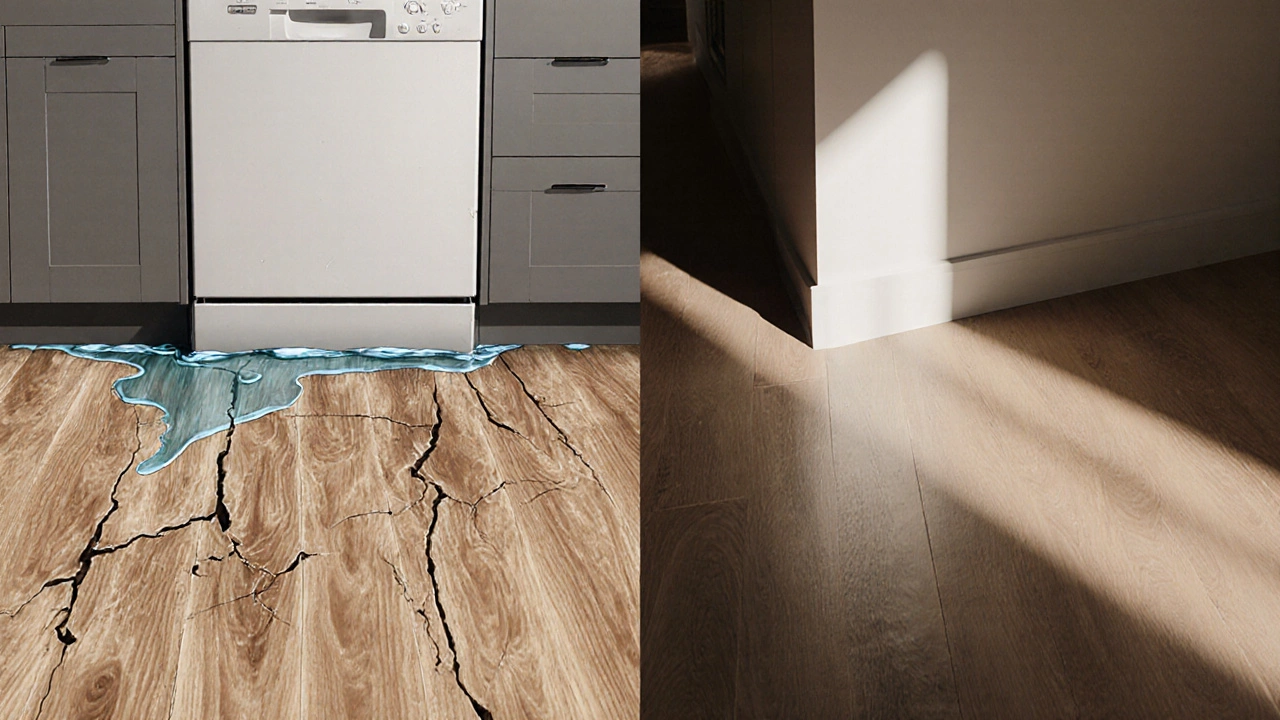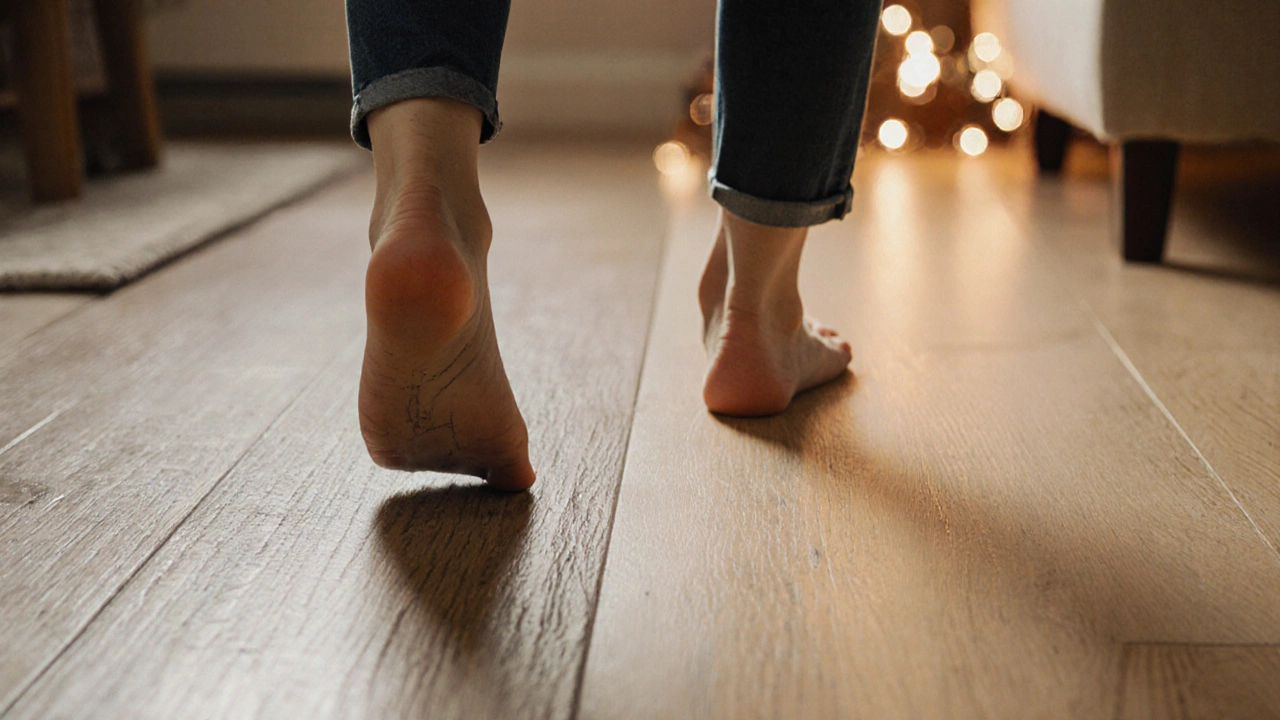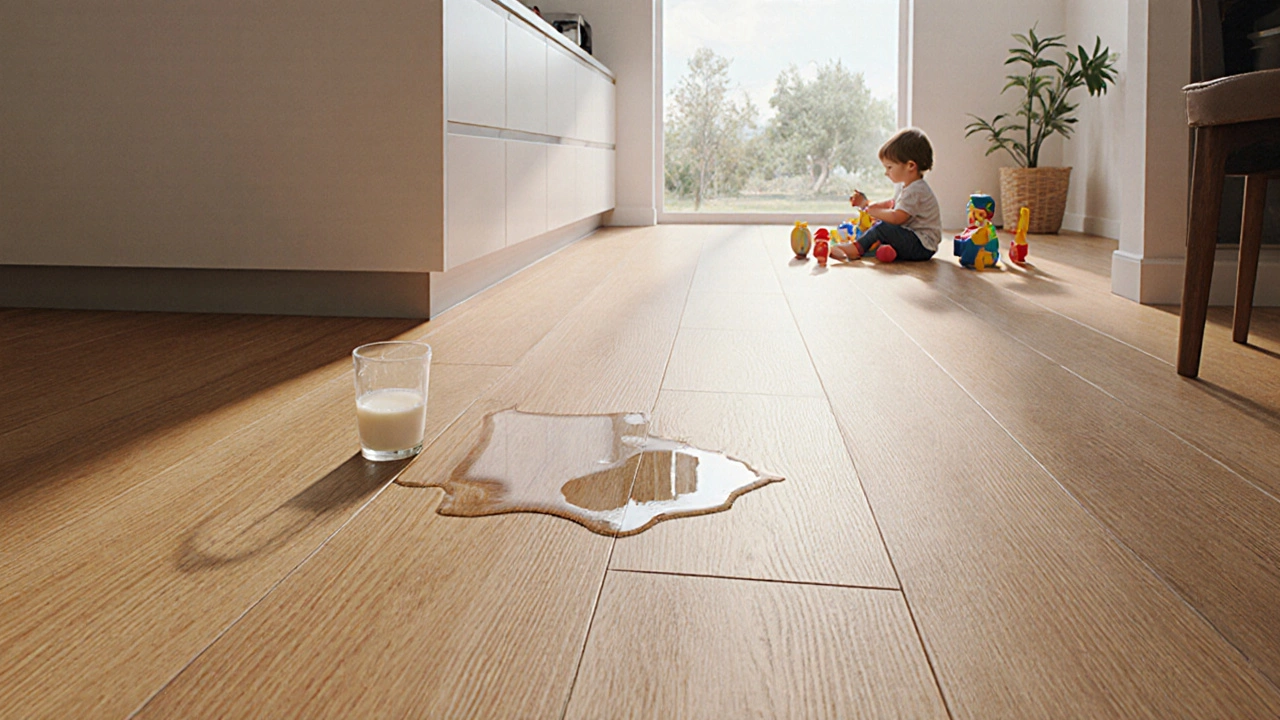When you’re standing in the middle of a hardware store, staring at rows of vinyl and laminate planks, it’s easy to feel overwhelmed. Both look like wood. Both claim to be waterproof. Both are cheaper than real hardwood. But which one actually works better in your home? The answer isn’t just about price or looks-it’s about your lifestyle, your space, and what happens when things go wrong.
What’s the real difference between vinyl and laminate?
Vinyl and laminate might look similar, but they’re built completely differently. Laminate is made of layers: a high-density fiberboard core, a printed image layer that mimics wood or stone, and a clear protective top layer. It’s rigid. It clicks together like a puzzle. Vinyl, on the other hand, is made of polyvinyl chloride (PVC) and is flexible. It can be planks, tiles, or even sheets. The top layer is often a wear layer with a textured finish that feels like real wood underfoot.
Here’s the key: vinyl is waterproof. Not water-resistant. Waterproof. If you spill a glass of milk, leave it for hours, or even flood the kitchen during a pipe burst, vinyl won’t swell, warp, or bubble. Laminate? It will. Even the "waterproof" laminates on the market today still have fiberboard cores that absorb moisture over time. I’ve seen too many homes in Melbourne where a leaky dishwasher turned a beautiful laminate floor into a warped, buckled mess within months.
Where does each flooring type shine?
If you’re putting flooring in a bathroom, laundry, or basement, vinyl wins-no contest. It’s installed over concrete without needing a moisture barrier. It can handle wet feet, steam from showers, and spills from washing machines. I’ve installed vinyl in three rental properties over the last two years. All of them are still perfect, even with pets and kids.
Laminate, though, does better in dry, high-traffic areas like living rooms, hallways, and bedrooms. It’s harder and more scratch-resistant than vinyl, especially the higher-end options with AC3 or AC4 ratings. If you’ve got dogs with claws or kids dragging toys across the floor, laminate holds up better against scuffs and dents. But don’t let that fool you-vinyl has come a long way. Modern luxury vinyl plank (LVP) now has ceramic bead or aluminum oxide coatings that rival laminate in scratch resistance.
How do they feel underfoot?
This is where most people make a mistake. Laminate feels hard. Cold. Like walking on a table. It echoes. In a big open-plan home, footsteps sound like drumbeats. Vinyl, especially the thicker 5mm+ planks with attached underlayment, feels warmer and more cushioned. It absorbs sound. It’s gentler on knees and joints. If you’re standing at the kitchen counter for hours, or have elderly family members moving around, that difference matters more than you think.
One client in Carlton switched from laminate to vinyl after her mother fell and fractured her hip. She didn’t blame the floor-but she noticed how much quieter and softer the vinyl felt. She said, "It doesn’t feel like I’m walking on cardboard anymore."

Installation: DIY-friendly or professional job?
Both vinyl and laminate are marketed as "easy DIY". And both can be installed by someone with basic tools. But here’s the catch: vinyl is more forgiving. It doesn’t need expansion gaps as wide as laminate. It can be glued down, floated, or even installed over existing tile (if it’s flat). Laminate needs a perfectly level subfloor. If your concrete slab has a 2mm dip, laminate will click and pop. Vinyl just bends over it.
Also, vinyl doesn’t need a separate underlayment if it has one built in. Laminate almost always does. That’s an extra cost and another layer to mess up. I’ve seen DIYers skip the underlayment to save $50-and end up with a floor that sounds like a drum kit every time someone walks.
Long-term durability and repairs
Laminate can last 15-25 years if treated well. But if one plank gets damaged? You have to remove a whole section to replace it. It’s like pulling a Lego piece out of the middle of a tower. Vinyl, especially the newer rigid core types, allows you to pop out a single plank and snap in a new one. No glue. No tools. Just lift and replace.
And what about fading? Sunlight hits floors hard in Australian homes. Vinyl has UV stabilizers built in. Most quality vinyl won’t fade for 20+ years. Laminate? The printed image layer can fade or bleach out over time, especially near large windows. I’ve seen homes in St Kilda where the sun-facing half of the living room floor looked like a different color than the shaded side.
Cost: What are you really paying for?
At first glance, laminate looks cheaper. You’ll find options for $15-$25 per square meter. Vinyl starts around $25 and goes up to $80 for premium luxury planks. But here’s what most people forget: installation cost. Laminate needs underlayment, transition strips, and often professional installation if your subfloor isn’t perfect. Vinyl can be installed over most existing floors, saving you demolition and prep costs.
Over five years, the total cost of ownership often favors vinyl. Why? Fewer repairs. No warping. No moisture damage. One client in Footscray replaced her laminate floor twice in six years because of two minor leaks. She switched to vinyl the third time-and hasn’t had a single issue since.

What about style and realism?
Both can look amazing. High-end vinyl now uses 4K imaging, embossing, and beveled edges that mimic hand-scraped oak or river stone so well, even contractors can’t tell the difference. Some brands even include realistic wood grain texture that changes under different lighting. Laminate has improved too, but it still looks flat in certain lights. The grain doesn’t vary enough. It’s printed, not carved.
One thing vinyl does better: it can mimic stone, concrete, and even metal finishes. Laminate struggles with non-wood looks. If you want a modern concrete look in your kitchen or a marble effect in your bathroom, vinyl is your only real option.
Environmental impact
Vinyl is made from petroleum. That’s not great. But modern vinyl is recyclable, and many brands now use recycled content. Some, like Armstrong’s BioBased line, are made with 80% renewable materials. Laminate is mostly wood fiber and glue. It’s not toxic, but it’s not biodegradable either. Neither is truly "eco-friendly," but if you’re choosing between the two, vinyl has more options for sustainable sourcing now.
Final verdict: Which should you choose?
If your space gets wet, has kids, pets, or aging family members-go with vinyl. It’s more forgiving, quieter, and won’t fail when water shows up. It’s the smart, long-term choice for kitchens, bathrooms, basements, and busy family homes.
If you want a classic wood look in a dry, low-moisture room like a bedroom or formal living room-and you’re willing to baby it-laminate still works. Just make sure it’s AC4 rated, has a thick wear layer, and you install it properly.
There’s no "best" flooring. There’s only the best flooring for your life. Ask yourself: What’s the worst thing that could happen to this floor? Then pick the one that handles it without breaking.
Can vinyl flooring be installed over existing laminate?
Yes, vinyl can be installed over existing laminate as long as the surface is flat, clean, and secure. If the laminate is loose, cracked, or uneven, it will show through the vinyl. Always check for moisture issues first-laminate can trap moisture underneath, which could damage vinyl over time.
Is vinyl flooring warmer than laminate?
Yes, vinyl feels warmer underfoot because it’s made of flexible PVC that retains heat better than the dense fiberboard core in laminate. Vinyl with a built-in underlayment adds extra insulation, making it noticeably more comfortable in colder months, especially in homes without radiant heating.
Does vinyl flooring scratch easily?
Modern luxury vinyl plank (LVP) has a wear layer with aluminum oxide or ceramic bead protection that resists scratches better than most laminates. While heavy furniture or pet claws can still leave marks, the damage is usually surface-level and can often be buffed out. Laminate scratches more deeply and permanently.
How long does vinyl flooring last?
Quality vinyl flooring lasts 20-30 years with proper care. Many manufacturers offer 25-year residential warranties. The key is choosing a product with a thick wear layer (at least 0.55mm) and a rigid core for high-traffic areas. Cheaper vinyl under 0.3mm wear layer may only last 10-15 years.
Can you use a steam mop on laminate flooring?
No. Steam mops release moisture and heat that can seep into the seams and core of laminate flooring, causing it to swell, warp, or delaminate. Even "waterproof" laminates aren’t designed for steam. Vinyl, however, handles steam mops fine-just keep the nozzle moving and avoid holding it in one spot for too long.


